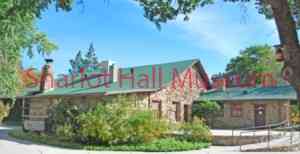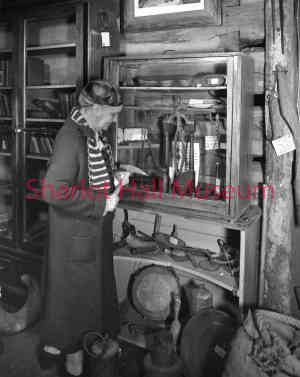By Dr. Sandra Lynch, Adjunct Curator -- Sharlot Hall Museum
The concept of a museum originated more than two millennia ago with Ennigaldi, a Babylonian princess. She lived in Ur, in today's Iraq, about 530 BCE (Before Common Era). Her father, Nabonidus, was the last king of the Neo-Babylonian Empire. He cared little about governance, which might explain why he was the "last king.” Instead, his life-long pleasure was digging for artifacts from earlier kingdoms. He might have been the world's first archaeologist.
 Ennigaldi honored him with a palace-sized temple to house and exhibit his treasures. The ruins of Ennigaldi's museum rested under 2000 years of shifting sand until 1925, when British archaeologist Leonard Woolley excavated the site. Woolley found dozens of artifacts "neatly arranged, side by side, varying from each other according to centuries." Curiously, each artifact was accompanied by a terra-cotta cylinder which described the artifact in three languages. Ennigaldi's cylinders were the world's first museum labels -- handy to have to catalog a collection.
Ennigaldi honored him with a palace-sized temple to house and exhibit his treasures. The ruins of Ennigaldi's museum rested under 2000 years of shifting sand until 1925, when British archaeologist Leonard Woolley excavated the site. Woolley found dozens of artifacts "neatly arranged, side by side, varying from each other according to centuries." Curiously, each artifact was accompanied by a terra-cotta cylinder which described the artifact in three languages. Ennigaldi's cylinders were the world's first museum labels -- handy to have to catalog a collection.
Why do we have museums, for what purpose? Every introductory course in museum studies answers: "to collect, preserve, interpret, and exhibit." Then come descriptive lessons on things that matter, like art, culture, history, archaeology, paleontology, and zoology. Interpretation and exhibition, in many forms, are the museum’s communication with its public, through which they strive to educate, entertain, and enlighten.
A museum is no amusement park, no Disneyland, no Universal Studios. Museums offer the real thing. People come to museums to feel they are in the presence of something real. A Jurassic Park, complete with walking, belching animatronic dinosaurs, cannot create the awe of standing in the rotunda of Chicago's Field Museum staring up, way-up, into the eye sockets of a fossilized tyrannosaur named "Sue."
How is it that we have museums? A great example is the Smithsonian Institution. James Lewis Smithson, an Oxford-educated Englishman who died in 1829, never visited the United States; he had no known friends or relatives here. In 1835, the primary beneficiary of his estate, a nephew, also died. Smithson's will stipulated that if the nephew lacked minor-aged children," ...his estate would be bequeathed to the government of the United States of America, to found at Washington, under the name of the Smithsonian Institution, an establishment for the increase and diffusion of knowledge among men.” England did not easily give up Smithson's funds. Four U.S. delegations argued in British courts. In 1838 the estate was awarded to America. The delegates returned with eleven boxes of gold sovereigns, which were recast at the U.S. mint into $508,318.46 in U.S. currency -- nearly 2% of the Federal budget. As might be expected, Congress argued over use of the money, but a decade later Congress established the Smithsonian Institution.
Not all museums are built by royals, the super wealthy, or the powerful. Many museums start out as grass-roots historical societies. Rich or poor, they represent the human will to preserve and protect the memories, memorabilia, and stories of the accomplishments of those who have gone before.
 Sometimes a museum begins in a young woman's dreams. From the late 1800s, Sharlot M. Hall was eyewitness to the vanishing West. Settlers died, their worldly possessions and life stories -- lost. Across Arizona Territory, ancient ruins were being looted to supply museum shelves and personal collections far away. As early as 1907, Sharlot began to think about the museum that would hold and protect her collections and the artifacts, documents, and stories that still lingered here, before they were lost and forgotten.
Sometimes a museum begins in a young woman's dreams. From the late 1800s, Sharlot M. Hall was eyewitness to the vanishing West. Settlers died, their worldly possessions and life stories -- lost. Across Arizona Territory, ancient ruins were being looted to supply museum shelves and personal collections far away. As early as 1907, Sharlot began to think about the museum that would hold and protect her collections and the artifacts, documents, and stories that still lingered here, before they were lost and forgotten.
In 1927, Sharlot signed a lease with the City of Prescott to move into the old gubernatorial mansion at Prescott and care for "this relic" -- for life. At the time, her personal collection was valued at $10,000 and included objects from Arizona ruins, Indian reservations, pioneers, ranchers, miners, and an eclectic group of Sharlot's remarkable friends. Her accumulations also included oral histories and historic documents. In exchange for her collection, the city promised free water, electricity, and police and fire protection.
In a formal letter to the Prescott City Attorney, Sharlot wrote:
"I wish absolute freedom to develop the land around the building into the most beautiful park possible -- in time -- and to place upon it whatever buildings or objects may be in harmony with the original purpose and a contribution to its realization. I expect to make my home in the building for such time as that may contribute to the development of the museum plan and the care of the objects assembled."
From Ennigaldi to Sharlot Hall, from a stone palace to an attic above a cross-cut planked cabin, museums are important and cherished measures of human civilization.
“Days Past” is a collaborative project of the Sharlot Hall Museum and the Prescott Corral of Westerners International (www.prescottcorral.org). This and other Days Past articles are also available at www.sharlothallmuseum.org/library-archives/days-past. The public is encouraged to submit proposed articles to dayspastshmcourier@gmail.com. Please contact SHM Library & Archives reference desk at 928-277-2003, or via email at dayspastshmcourier@gmail.com for information.


